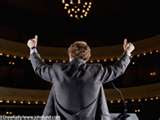To All Presenters:
Effective communication requires multiple parts:
Encoding (the speaker translates conceptual thoughts into words);
Transmitting (those words are spoken aloud in a common language);
Receiving (those words are heard by the audience);
Decoding (those words are understood and translated into concepts).
Those last two steps - Receiving and Decoding could easily be lumped together in a gushy ball and called "listening". While your delivery of a message certainly comes with its own opportunities for failure - listening is most commonly where the train goes off the tracks, over the cliff, into the ravine and bursts into flames upon the jagged rocks hundreds of feet below.
More scientific communicologists than I will oft divide listening into three categories:
Competitive or Combative Listening happens when one is more interested in promoting one's own perspective than in understanding or exploring someone else’s. In this case the listener either seeks opportunities to speak, or focuses on finding flaws or weaknesses in a presentation which can be attacked. This type of listening is all too common in audiences - and seems especially popular during product demos and sales presentations.
Passive or Attentive Listening occurs when one is genuinely interested in hearing and understanding the another's point of view. One may be attentive and passively listen without actively verifying what was understood to be said. This type of listening generally results in subsequent discussions of the, "I know you think you understand what you thought I said, but what you thought I said isn't what I meant" type most common in IT development projects and marriages.
Active or Reflective Listening is the single most useful and important listening type. In active listening one is so genuinely interested in understanding what another person is thinking, feeling, wanting or what the message really means. To that end the recipient will reiterate or paraphrase the message and reflect it back to the sender for verification. This verification or feedback process is what distinguishes active listening and makes it the most effective means of assuring accurate communication. It's also how lawyers badger witnesses.
Of course there are alternative opinions.
Robert K. Cooper, popular leadership consultant and author, says, "Many 'active listening' seminars are, in actuality, little more than a shallow theatrical exercise in appearing like you're paying attention to another person. The requirements: Lean forward, make eye contact, nod, grunt, or murmur to demonstrate you're awake and paying attention, and paraphrase something back every 30 seconds or so. As one executive I know wryly observed, many inhabitants of the local zoo could be trained to go through these motions, minus the paraphrasing."
THE POINT: Better, perhaps, to consider a quote from Frank Tyger, "Be a good listener. Your ears will never get you in trouble."

